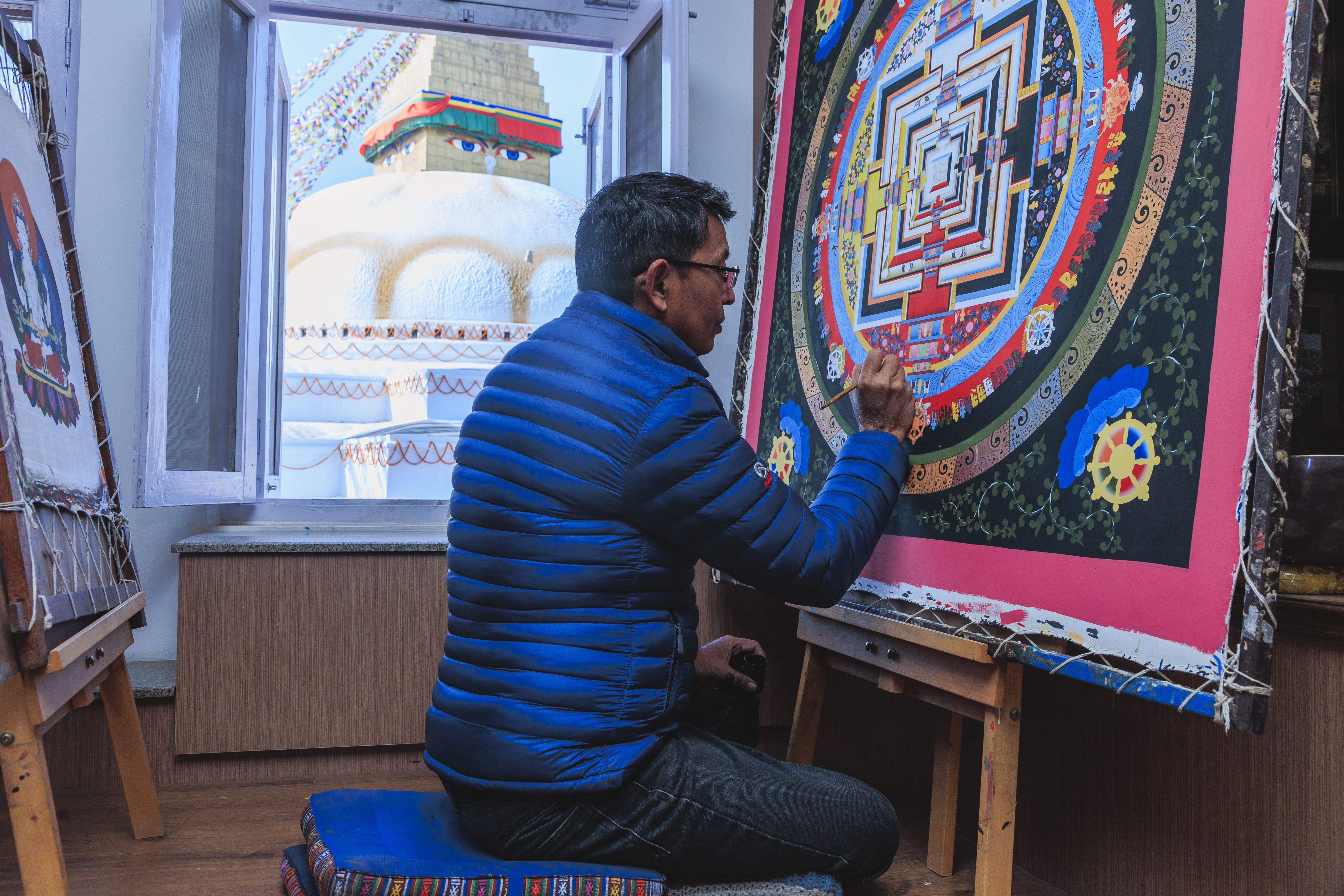
History and Evolution of Thangka Painting
Origin of Thangka Painting
From the early 11th century, thangka painting history was introduced in Nepal. Thangka painting was traditionally involved between the 7th and 12th centuries in Tibet. Thangka painting is originally connected with Buddha’s life, Anathapindika, his main patron. As the illustration of the deities and natural scenes were introduced by Buddhists and Hindus the history was started. Thangka is the Tibetan word that came from “thang yig” meaning a written record. Tibetan thangka is Buddhist paraphernalia. In Nepali and Newari, this sacred painting is known as Paubas.
The history of thangka painting is uniquely evolved in Tibetan tradition, particularly during the 7th and 12th centuries. For newly built monasteries in Tibet, there was a great demand for religious icons and Buddhist manuscripts, leading to the creation of intricate thangka paintings. Various Prajnaparamita texts and manuscripts were meticulously copied in the Kathmandu Valley to supply these monasteries with revered artifacts.
As time progressed into the thirteenth century, the influence of Nepalese art related to the history of thangka painting extended beyond China in a systematic manner. Notably, Chinese emperors recognized the expertise of Nepalese artisans and dispatched them to the imperial court, seeking their skillful workmanship and expert knowledge to further enhance the artistic legacy of thangka painting.
As thangkas are distinctly Tibetan art styles, they originated in India with the influence of China and Nepal. In Nepal, a small subgroup of the Newar first created the Thangkas and was responsible for creating masks and paintings.
Deities in Historical Thangka Paintings
Mahakala Thangka: Mahakala is one of the protective deities in Buddhism and is being depicted in thangka paintings by ancient monks. Mahakala thangka is being an aid for tantric practitioners to achieve enlightenment.
Wrathful Deities Thangka: Some of the wrathful deities like Chakrasabhara, Vajrayogini, Vajrapani, Vajrakilaya, Sinhamukha, Kalachakra Deity, Palden Lhamu are being written on the thangka paintings. The fierce, wrathful or forceful deity would eliminate the obstacles and negative energy helping monks and buddhist tantra practitioners to achieve enlightenment.
Peaceful Deities Thangka: The buddhist followers used the peaceful deities thangka as an aid of meditation, visualization, and spiritual practice. These thangkas typically depict serene and benevolent deities, such as Avalokiteshvara (the Bodhisattva of Compassion), Zambala, Saraswati, Chenrezig, or Amitabha Buddha, who embody peace, compassion, and wisdom.
Tara Thangka: Tara is often shown in her green or white forms, embodying active compassion and peacefulness, respectively. Buddhist practitioners use Tara thangkas for meditation, seeking her guidance, protection, and blessings for overcoming obstacles and fears.
Mandala Thangka: A Mandala thangka represents the universe's spiritual and cosmic order, typically depicted as a geometric design with intricate patterns. Used in meditation, it helps practitioners focus and connect with the divine, guiding them on their path to enlightenment by symbolizing the journey from the outer world to the inner spiritual core.
Life of Buddha Thangka: A Life of Buddha thangka narrates the key events in Buddha's life, from his birth to his enlightenment and teachings. It serves as a visual biography and teaching tool, helping practitioners reflect on Buddha's journey, understand his teachings, and gain inspiration for their own spiritual path.
Wheel of Life Thangka: The Wheel of Life thangka, or Bhavachakra, illustrates the Buddhist cycle of birth, life, death, and rebirth (samsara). It depicts the realms of existence, karma, and the causes of suffering. This thangka serves as a reminder of the impermanence of life and the importance of pursuing liberation from the cycle of samsara.
Materials Used to Prepare a Thangka Painting in Past
As the preparation process is the same as in the past, there was a systematic and orderly way to pursue the art of painting. There were and are five straightforward steps for creating thangka scroll paintings:
- Preparation of the painting surface is the first step in the process
- Establishing the design on that surface through the means of sketch
- The third step includes laying down the initial coats of paint and is followed by step four
- The fifth step covers a part of Outlining and Shading
- The last and sixth step consists of several finishing touches.
While painting thangkas more than one painting medium is applied in their basic coats of color in distemper. With a binder of gelatin size, the distemper consists of powdered pigments.
Paints used in thangka are water-soluble and fast-drying, and a matte finish can be seen at last. The standard opaque distemper is the most commonly used mixture of glue. Hide glue is the binder that holds pigments together and can be used in different ways. Such kinds of paints used are known as Tibetan rdzags or tshan chen. The technique of applying thinner, more transparent washes of paint is Contrasting.
Hang Tshan technique once was a shortcut method in mural painting, but in thangkas, it was used to cover up only small figures. For relatively large and distinct areas of color, distemper was suited to design. It created difficulties in handling many small or convoluted area designs.
Note: The historical methods of painting thangka are still followed today by modern artists, yet there have been notices of adjustments in techniques.
The Painting Surface
The painting Surface consisted of two main layers: a support and a ground. There were supporting materials on the core of a painting surface such as cloth, bare wall, or wooden panel. Support of the painting is the underlying material held or carried on layers of ground. As there are various supports used by many artists, walls, and cloth are the most common ones.
Cotton Canvas
Canvas were made of cotton cloth, preparing the cloth was the first item to prepare a thangka. Plain weave was the most common cloth used by artists. In the case of Nepal and India, light-weight cotton is used by modern artists. Thicker coats of gesso were used to fill in the textured surface of the Cotton coarser weave.
For the preparation of larger paintings, it was necessary to stitch two pieces of cloth. Clothes should be washed sometimes before the preparation. After drying the cloth, monks cut the cloth to fit in the wooden stretcher frame. In the past, Silk, leather, linen, and skin were also executed on scroll Painting.
The Stretcher
After the preparation of cotton cloth for the painting surface it was stretched in a wooden frame (rk yang shing). Now the layers of paint were coated on the ground. There were various dimensions of stretchers used by monks/painters. Rectangular single thangka was the most common type of single thangka. At the time of fastening the cloth, it looked something like a miniature trampoline. Wooden Stretchers were and are one of the artist's necessities.
The Inner Frame
Inner Frame usually means to fasten the cotton cloth with the stretcher. It has two main steps to fasten the cloth. The First Sort of the inner frame is stitched by the painter, which consists of bamboo splints or supple wings, on the edge of the fabric. Secondly, the cloth is fastened with its light frame of twigs to the heavier outer stretcher. The inner frame helps to distribute the tension along the edges of the fabrics and the tension remains stable until the completion of the painting. The inner frame is crucial for ancient thangka artists as well.
The Evolution in Style
The style of painting thangkas has evolved significantly over time, influenced by culture, geography, and modern interpretations. Traditionally rooted in Tibetan Buddhism, thangka painting spread to Nepal, Bhutan, and parts of Japan, each region adding its distinct artistic flavor.
In Nepal, Newar artists integrated intricate details and vibrant colors, while Bhutanese thangkas retained a more conservative, spiritually focused style. In Tibet, the art evolved with regional variations, incorporating Chinese influences during the Yuan dynasty. Japanese thangkas, often referred to as mandalas, emphasize symmetry and abstract designs.
Modern artists have introduced different types of thangka paintings as they are tend to adopt modern styles, contemporary elements, blending traditional iconography with new mediums and themes, while still respecting the spiritual essence of thangkas. This evolution reflects a dynamic interplay between tradition and innovation, allowing thangkas to remain relevant in both religious and artistic contexts.
Also read: Significance of thangka painting in Buddhism
Thangka Painting in Modern Days
In modern times, thangka painting has transcended its traditional roots, gaining recognition as both a spiritual and artistic practice. Contemporary artists are exploring new styles, materials, and themes, merging ancient iconography with modern aesthetics. While maintaining the spiritual significance of thangkas, these artists are also making them accessible to a global audience, often through exhibitions, workshops, and online platforms.
Additionally, thangka painting is being revived as a cultural heritage practice, with efforts to preserve traditional techniques and pass them on to new generations. This fusion of tradition and innovation keeps thangka painting vibrant in the modern era.
Conclusion
Thangka painting, a sacred art form rooted in Tibetan Buddhism, has evolved over centuries. Originating in Nepal and Tibet between the 7th and 12th centuries, thangkas were created as religious icons and teaching tools.
The art spread to Bhutan, Japan, and beyond, with each culture adding unique styles. Traditional thangkas were painted on cotton or silk, using intricate techniques. Modern artists continue to innovate, blending ancient symbols with contemporary elements.
Today, thangka painting remains a vibrant tradition, cherished both for its spiritual significance and as a cultural heritage, passed down through generations.



